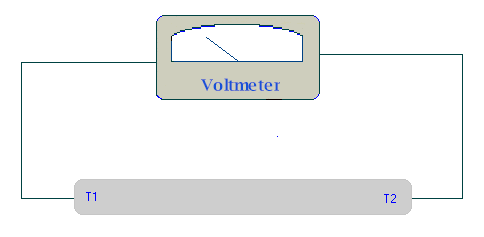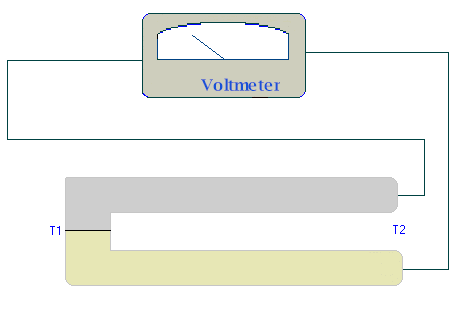A temperature difference between any two points in a normal metal will result in an electrostatic potential difference (V1) if no electrical current is allowed to flow between those two points. This potential difference is proportional to the temperature difference T1-T2 between those two points as shown in figure 1 below.

However, the attached voltmeter actually measures the potential drop across all the metal items between its terminals. This includes the aforementioned strip of metal, and also the two wires used to connect it to the voltmeter terminals.
To counterbalance the additive potential arising from the connecting wires, a strip of metal dissimilar to the first is attached serially to the first, such that its ends too are between the temperatures T1 and T2. This is shown schematically in Fig 2. This results in a sum of potentials measured by the voltmeter firstly, the potential (V1) that arises in the first metal from temperatures T2 to T1, secondly, the potential (V2) that arises in the second metal from temperatures T1 to T2. Now as long as the two metals are dissimilar, this sum of (V1 + V2) will not be zero.

The potential that is measured, is dependent upon the difference in temperatures (T1 - T2), and not the actual values of T1 and T2. Therefore, if we can fix one of those temperatures (T2) at a known value, we will be able to make accurate temperature measurements. An easy way to fix the temperature of T2, is to have it in an ice water bath; as long as ice is present, and in equilibrium with the water, the temperature of the water will be 0° Celsius.
We can connect the thermocouple leads that are in the ice water bath to the Digital Multimeter (DMM) by lengths of wire. Now these lengths of wire, have to both be the same types of metals. The reasoning for this, is the same as that for the thermocouple being made of dissimilar metals. The potential of the system, is the sum of the individual potentials that arise throughout the system. Starting at the DMM, we have the potential V0 that arises though our first lead, going from room temperature to 0°C. Then we have the aforementioned, (V1 + V2) of the thermocouple, and finally the potential that arises within our second DMM lead, as it goes from 0C to room temperature V3. If the strips of wire that attach the DMM to the thermocouple are the same, then the potential V0 cancels out the potential V3. The DMM then only displays the potential (V1 + V2), which is what is required to make the temperature measurement.
Using a thermocouple to make accurate measurements
Figure 3 shows how one can set up a thermal couple using a reference junction. The thermocouple measuring junction is at the unknown temperature, T1, and the reference junction is at the known temperature, T2, which in this case is 0°C.
Information Courtesy of CSI Superconductors

